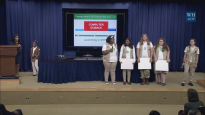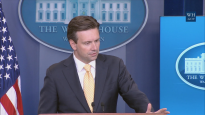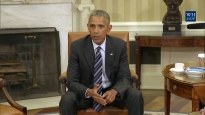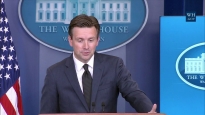President Obama Speaks on Response to the California Drought
February 14, 2014 | 11:56 | Public Domain
President Obama delivers a statement about the ongoing response effort to the historic California drought.
Remarks by the President on the California Drought
4:55 P.M. PST
THE PRESIDENT: Well, first of all, I want to thank Joe and Maria Del Bosque and their beautiful daughters for showing Governor Brown and me around their farm.
Joe has got an incredible story. The son of a migrant farmworker, farm work is how he put himself through college. He’s been a farmer for most of his life. He started by going around to other folks’ land and saying, I'll grow some cantaloupes for you as long as you pay me for what we produce, and over the years was able to develop this amazing business and not only start growing cantaloupes, but almonds and cherries and all kinds of other good stuff.
“There are three things that make farming work in California,” according to Joe, “soil, water, and people.” And in the little free time they have, Joe and Maria work to improve the health and safety of farm workers. There are a lot of people who are dependent on him year-round, and a lot of people who work seasonally with Joe and Maria, and their livelihoods depend on the functioning of these farms.
But today, we’re here to talk about the resource that’s keeping more and more California’s farmers and families up at night, and that is water -- or the lack of it.
As anybody in this state could tell you, California’s living through some of its driest years in a century. Right now, almost 99 percent of California is drier than normal -- and the winter snowpack that provides much of your water far into the summer is much smaller than normal. And we could see that as we were flying in -- Jim and Barbara and Dianne and I were flying over the mountain ranges and could see, even though there was a little bit of snow that just came in the last couple of days, that it’s nothing like it is normally.
While drought in regions outside the West is expected to be less severe than in other years, California is our biggest economy, California is our biggest agricultural producer, so what happens here matters to every working American, right down to the cost of food that you put on your table.
And that’s why, last month, Governor Brown declared a state of emergency, directing state officials to prepare for drought conditions. And together, our administrations launched a coordinated response. Secretary Vilsack, who is here today, declared 27 counties as primary natural disaster areas, making farmers and ranchers eligible for emergency loans. And over the past two weeks, his team at USDA and Mike Connor’s team at the Interior Department have released new funds for conservation and irrigation; announced investments to upgrade water infrastructure; and partnered with California to stretch the water supply as much as possible.
Today, I’m want to announce new actions that we can take together to help these hardworking folks.
First, we’re accelerating $100 million of funds from the farm bill that I signed last week to help ranchers. For example, if their fields have dried up, this is going to help them feed their livestock.
Second, last week, we announced $20 million to help hard-hit communities, and today, we’re announcing up to $15 million more for California and other states that are in extreme drought.
Third, I’m directing the Interior Department to use its existing authorities, where appropriate, to give water contractors flexibility to meet their obligations.
And fourth, I’m directing all federal facilities in California to take immediate steps to curb their water use, including a moratorium on water usage for new, non-essential landscaping projects.
A bipartisan bill written by your outstanding Senators, Dianne Feinstein and Barbara Boxer, as well as your own outstanding Representative and almond farmer, Jim Costa, includes similar ideas. And I hope that Congress considers the legislation that they have crafted soon, work through some of the concerns that have been expressed -- let’s make sure that we're getting some short-term relief to folks, but also long-term certainty for people who are going to be harmed by this drought.
These actions will help, but they’re just the first step. We have to be clear: A changing climate means that weather-related disasters like droughts, wildfires, storms, floods are potentially going to be costlier and they’re going to be harsher. Droughts have obviously been a part of life out here in the West since before any of us were around and water politics in California have always been complicated, but scientific evidence shows that a changing climate is going to make them more intense.
Scientists will debate whether a particular storm or drought reflects patterns of climate change. But one thing that is undeniable is that changing temperatures influence drought in at least three ways: Number one, more rain falls in extreme downpours -- so more water is lost to runoff than captured for use. Number two, more precipitation in the mountains falls as rain rather than snow -- so rivers run dry earlier in the year. Number three, soil and reservoirs lose more water to evaporation year-round.
What does all this mean? Unless and until we do more to combat carbon pollution that causes climate change, this trend is going to get worse. And the hard truth is even if we do take action on climate change, carbon pollution has built up in our atmosphere for decades. The planet is slowly going to keep warming for a long time to come. So we’re going to have to stop looking at these disasters as something to wait for; we've got to start looking at these disasters as something to prepare for, to anticipate, to start building new infrastructure, to start having new plans, to recalibrate the baseline that we're working off of.
And everybody, from farmers to industry to residential areas, to the north of California and the south of California and everyplace in between, as well as the entire Western region are going to have to start rethinking how we approach water for decades to come.
And as I said when I was meeting with the town hall group, we can't think of this simply as a zero-sum game. It can't just be a matter of there’s going to be less and less water so I'm going to grab more and more of a shrinking share of water. Instead what we have to do is all come together and figure out how we all are going to make sure that agricultural needs, urban needs, industrial needs, environmental and conservation concerns are all addressed. And that's going to be a big project, but it's one that I'm confident we can do.
Part of the Climate Action Plan that I put forward last summer is designed to protect critical sectors of our economy and prepare the United States for the effects of climate change that we’re just not going to be able to avoid. So, last week, for example, the USDA announced seven new “climate hubs” to help farmers and ranchers adapt their operations to a changing climate -- one of which will be at UC Davis, focused on resilience for California’s specialty crops.
The budget that I sent to Congress -- the budget that I send to Congress next month will include $1 billion in new funding for new technologies to help communities prepare for a changing climate, set up incentives to build smarter, more resilient infrastructure. And finally, my administration will work with tech innovators and launch new challenges under our Climate Data Initiative, focused initially on rising sea levels and their impact on the coasts, but ultimately focused on how all these changes in weather patterns are going to have an impact up and down the United States -- not just on the coast but inland as well -- and how do we start preparing for that. And that has to be work that we do together. This cannot be a partisan endeavor.
One of the great things about that town hall that I just came out of -- not everybody agreed on anything -- (laughter) -- except people did agree that we can't keep on doing business as usual. That's what people did understand -- that there has to be a sense of urgency about this.
And issues like the federal government helping states to build infrastructure to adapt and ensure economic development and that families and workers are able to prosper -- there’s nothing new about that. We just saw a photograph of President Kennedy and current Governor Brown’s dad building some of the aquifers that have been so important to the economy of this state for decades. If we were able to do that then, we should be able to do it now. It's just a matter of us making sure that we're not putting politics ahead of trying to get things working.
Our work with Governor Brown and his administration is going to continue. Californians have all had to come together and already make sacrifices, big and small, to help your neighbors and your state get through this. The good news is California is always on the cutting-edge. Already you use water far more efficiently than you did decades ago. You do it smarter. Joe was explaining just how this drip irrigation that you see in this region has made many of these farms much more efficient when it comes to water utilization. And so we know that we can innovate and meet this challenge, but we've got to start now. We can't wait.
So I want to make sure that every Californian knows -- whether you’re NorCals, SoCal, here in the Central Valley -- your country is going to be there for you when you need it this year. But we're going to have to all work together in the years to come to make sure that we address the challenge and leave this incredible land embodied to our children and our grandchildren in at least as good shape as we found it.
So, thank you very much, everybody, for the great work that you guys do. And I've already told the Governor as well as all your outstanding representatives here that our administration is going to stay on this and we are prepared to cooperate with local, state officials throughout. And that's not just in California, because we're going to see some similar problems in places like Colorado, Nevada, some of the neighboring Western states, and so part of the conversation is also going to have to be a regional conversation.
But this is something that I'm very committed to. We're going to make sure to get it done, working together. Thank you so much, everybody. (Applause.)
END 5:08 P.M. PST
|
September 14, 2016
|
September 14, 2016
|
September 14, 2016
|
September 14, 2016
|
|
September 12, 2016
|
September 12, 2016
|
September 12, 2016
|
September 12, 2016
|
- &lsaquo previous
- …
- 23
- 24
- 25
- 26
- 27
- 28
- 29
- 30
- 31
- …
- next &rsaquo







